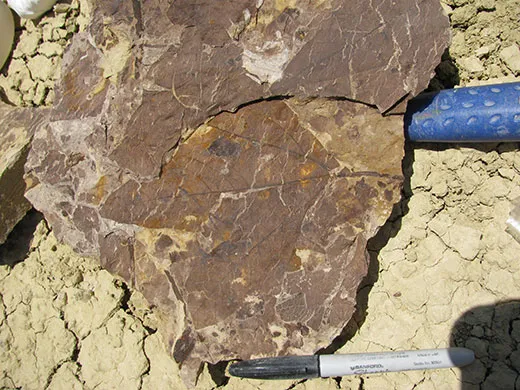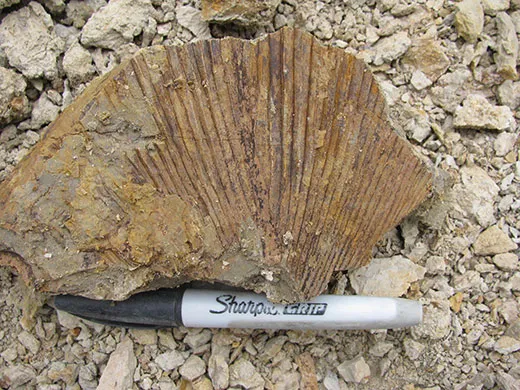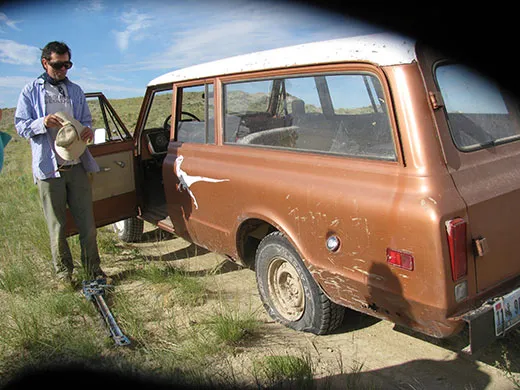Wyoming Paleontology Dispatch #3: How to date a fossil
The Bighorn Basin’s colorful stripes reveal an ancient riverbed
/https://tf-cmsv2-smithsonianmag-media.s3.amazonaws.com/filer/Wyoming-Dispatch-fossil-palm-frond-631.jpg)
The first day of the field season dawns clear and bright, with an already strong sun sliding up from behind Cloud Peak, the highest in the Bighorn Mountains. Down here in the basin it is already warm at 6 a.m., and the inside of a tent gets unbearably hot within an hour of sunrise, so there is every reason to rise, make coffee, pack some sandwiches, fill the water containers and jump into Dino for the drive to the first site where we are going to collect. On the way we stop briefly to pick up our fourth team member, Elizabeth Denis, a graduate student at Penn State University.
The plant fossil site we are headed to, which has only my field number SW1010 as its designation, was an exciting find near the end of last year’s field season. We approach by a circuitous route—first down a county gravel road, then a dirt road that runs between fields of alfalfa and sugar beets, then alongside an irrigation canal, across a plank bridge, finally finding a vague two-track that wanders off through the sagebrush and prickly pear toward a steep-sided badland divide. We get stuck in the mud in the first hour of the field season. Getting stuck at the outset causes some laughter among the crew, but I regain a bit of respect when it turns out to be only a few minutes’ work to dig out the tires and get on our way again.
Arriving at the site, we look up a narrow valley floored with sagebrush and walled in by steep badland slopes striped with red, orange and purple bands. Those bright stripes, which our eyes can follow around as if they were layers of a giant cake, are ancient flood plain sediments, and their colors reflect the oxidation of iron as the deposits were chemically altered by weathering during the PETM. They are fossil soil horizons, and they are beautiful! The fossil plant site, by contrast, is not a wide, flat layer and it isn’t bright-colored. It’s a brownish gray deposit of mudstone about 10 feet thick and 100 feet wide. The bright-colored fossil soil layers lie above and below it on the same hillside.
The rock that contains plant fossils may not be beautiful, but the dull color is the secret to the preservation of the plant fossils—it indicates that this lens of rock was never oxidized, and that’s because it’s made of sediments that were deposited underwater in an abandoned river channel, where oxygen from the atmosphere couldn’t get to it. The fact that it formed in a former river channel also explains why these plant-fossil-bearing rocks have a lens shape in cross-section—the channel was deep in the middle and shallow at the edges.
The fossil leaves we find here are lovely, in my heavily biased opinion—intricate imprints that record microscopic details of vein structure. Some specimens are preserved in such detail that with a hand lens we can see the imprints of fine hairs or even the yellow-red shimmer of tiny amber blobs—the remains of oil-filled cells within the leaf like those that can be seen in bay leaves commonly used in making soup. The orange and red hues in the fossil leaves are not an original feature of some long-ago autumn; they result from the deposition of iron during chemical reactions set up by the decay of the leaves. We also find molds of the shells of ancient freshwater snails and crustaceans, and even the occasional imprint of a fish scale, all consistent with the idea that these rocks were deposited at the bottom of a quiet pond that formed when a small river channel closed off during the PETM.
One common question that comes up in talking about fossils is “How do you know how old they are?” This question is particularly important for us because we are searching for fossils from such a narrow interval of time. The answer has several parts. The most direct answer is that we know the rocks around SW1010 were deposited during the PETM because my colleague Ken Rose from Johns Hopkins University has been collecting fossil mammals here for a number of years. Many of the species Ken has found in this area occur only during the PETM, not before or after. This approach to determining the age of rocks is called biostratigraphy.
Of course biostratigraphy raises another question—how do we know these species lived only during the PETM? For that we turn to a distinctive chemical signature of the PETM: during the event there was a global shift in the ratio of the isotopes of carbon. The lighter form of carbon, carbon 12, became much more abundant relative to the heavier form, carbon 13. This shift, which we call the “carbon isotope excursion,” is seen everywhere from deep-sea sediments to rocks deposited by rivers in the Bighorn Basin. This chemical marker for the PETM has been found in rocks bearing fossil mammals in several parts of the Bighorn Basin, and it is always associated with a distinct set of species that don’t occur in rocks before or after the carbon isotope excursion.
Still, we haven’t answered the question about how we know the precise age of PETM fossils. For that information we have to turn to work elsewhere in the world, places where the carbon isotope excursion has been found in proximity to rocks containing volcanic crystals suitable for radiometric dating. Here, at last, scientists can measure the ratio of “parent” to “daughter” isotopes of radioactive materials in the volcanic crystals. Knowing the half-life of the parent isotope, they can calculate how many millions of years ago the crystals formed. It’s a long but logical process to go from wandering around the badlands of the Bighorn Basin to knowing that you are collecting fossils from 56 million years ago (give or take a few hundred thousand years). Most of the time we don’t think about it while we are in the field!
The first day starts with the excitement of any first day, but we can’t start collecting right away. First we have to clear away the mud that winter rains have made of the surface rocks we exposed last year. It’s strenuous, pick and shovel work, which we do while perched somewhat precariously on the steep side of a badland butte. It is a beautiful morning, though, and after an hour or so we are able to start pulling blocks of harder, fresh rock out of the outcrop. Each rock is a chance to find a fossil! We pick them up one by one and smack them on the side with the chisel end of a brick hammer, hoping they will split along an ancient bedding plane where leaves accumulated. Sometimes the block cooperates, sometimes not, but the fossil rewards come pretty steadily throughout the mid-morning and early afternoon. We are accumulating quite a nice pile of specimens—maybe 20 or 30—on ledges we have cut into the slope. And in the excitement of the day we have forgotten to eat lunch!
By 2 or 3 in the afternoon we are all flagging a little—not too surprising given that the temperature is in the high 90s, the air is very dry, and a little thinner at 5,000 feet than we are used to, and, oh yeah, the PB&J sandwiches are still in our packs. Sarah, Pam and Liz are clearly troopers to still be working, but we all need a quick lunch break. After bolting sandwiches it’s back to work, and in the waning heat we begin to think about the end of the day. We have to get all of our finds wrapped so we can get them in our backpacks, in the back of Dino and back to camp without having them break.
This begins the most tedious part of the day. Each specimen we collect has to be marked with the locality number and with an indicator of how many pieces it is in (not every rock breaks the way we want!). After marking them with a Sharpie pen, we wrap the rocks with fossils on them in industrial toilet tissue. The best brands are those without perforations, and I buy them in giant rolls because we use a lot! It’s very much like wrapping a sprained ankle with an Ace bandage in that we put a little pressure on as we wrap. This holds the rock and fossil together, and protects the delicate surface from being scraped or bashed by another rock. We use masking tape to close the package, and we mark the site number again on the outside so the packages can be sorted when we get back to the Smithsonian’s Natural History Museum. By the time we bump across the gullies and sagebrush back to camp, it’s close to 7 p.m. and the light is getting golden again. Dinner remains to be cooked, dishes to be done, but it has been a long and satisfying day.
Scott Wing is a research scientist and curator in the Smithsonian Institution’s Department of Paleobiology.
/https://tf-cmsv2-smithsonianmag-media.s3.amazonaws.com/accounts/headshot/SLW_photo_-James_Kegley_for_Smithsonian.jpg)



/https://tf-cmsv2-smithsonianmag-media.s3.amazonaws.com/accounts/headshot/SLW_photo_-James_Kegley_for_Smithsonian.jpg)